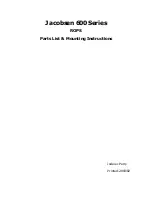
4. Gas Control Module (Enhanced)
2016-04
IFU for Infinite 200 PRO No. 30052730 Rev. No. 1.6
53
4. Gas Control Module
(Enhanced)
4.1
Safety
1.
Always follow basic safety precautions when using the gas control module to
reduce the risk of injury, fire, or electrical shock.
2.
Read and understand all information in this chapter. Failure to read,
understand, and follow the instructions in this chapter may result in damage
to the instrument or gas control module, injury to operating personnel or poor
instrument performance.
3.
The instrument covers of the gas control module protect the user; therefore,
do not remove any of the covers or perform any maintenance tasks other
than those described in this document.
4.
Observe all WARNING, CAUTION and IMPORTANT statements in this
chapter. Ensure that this safety information is accessible for every employee
working with the gas control module.
5.
Furthermore, it is assumed that instrument operators, due to their vocational
experience, are familiar with the necessary safety precautions for handling
gas and biohazardous substances. Adhere to the following guidelines:
WARNING
The gas control module (GCM) is designed
for CO
2
(carbon dioxide) and N
2
(nitrogen) supply
and must only be used by trained personnel.
Never use a flammable or cryogenic gas supply!
WARNING
ADEQUATE VENTILATION MUST BE PROVIDED
FOR THE ROOM IN WHICH CO
2
AND N
2
ARE USED.
WARNING
FOLLOW THE SECURITY MEASURES
FOR WORKING WITH COMPRESSED GAS! (TRANSPORTATION,
STORAGE, HANDLING AND USE).
THE CO
2
AND N
2
GAS CYLINDERS MUST BE SECURELY FASTENED
UPRIGHT TO A LARGE, STATIONARY OBJECT AT ALL TIMES.
ALWAYS PROTECT THE GAS CYLINDER FROM FALLING!
A COMPRESSED GAS CYLINDER WHICH FALLS AND IS DAMAGED
CAN EASILY BECOME A LETHAL PROJECTILE!
•
Wear protective glasses when using compressed gasses outside of the
instrument when the instrument is open.
•
Precautions must be taken when working with potentially infectious
material. Make sure to treat biohazardous material according to
applicable safety standards and regulations as well as good laboratory
practice guidelines.
















































